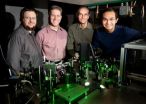(Press-News.org) A new process for creating a personalized vaccine may become a crucial tool in helping patients with colorectal cancer develop an immune response against their own tumors. This dendritic cell (DC) vaccine, developed at Dartmouth and described in a research paper published this week in the journal Clinical Cancer Research, was used after surgical resection of metastatic tumors to try to prevent the growth of additional metastases.
"The results of the study suggest a new way to approach cancer treatment," said Richard Barth Jr., MD, Chief of General Surgery at Dartmouth-Hitchcock Medical Center and a member of the Gastrointestinal Clinical Oncology Group at Dartmouth-Hitchcock Norris Cotton Cancer Center, who is the study's principal investigator. "Basically, we've worked out a way to use dendritic cells, which initiate immune responses, to induce an antitumor response."
Dendritic cells are critical to the human body's immune system, helping identify targets, or antigens, and then stimulating the immune system to react against those antigens. The new research grew dendritic cells from a sample of a patient's blood, mixed them with proteins from the patient's tumor, and then injected the mixture into the patient as a vaccine. The vaccine then stimulated an anti-tumor response from T-cells, a kind of white blood cell that protects the body from disease.
In the study, Barth first operated on 26 patients to remove tumors that had spread from the colon to the liver. While some of these patients would be expected to be cured with surgery alone, most of them would eventually die from tiny metastases that were undetectable at the time the tumors were removed from the liver. The DC vaccine treatment was given one month after surgery. The results were that T-cell immune responses were induced against the patient's own tumor in more than 60% of the patients. The patients were followed for a minimum of 5.5 years. Five years after their vaccine treatment, 63% of the patients who developed an immune response against their own tumor were alive and tumor-free. In contrast, just 18% of the patients who did not develop an immune response against their own tumor were alive and tumor-free.
"We showed that a tumor lysate-pulsed DC vaccine can induce immune responses against the patient's own tumor in a high proportion of patients," stated Dr. Barth, who has been investigating DC-based vaccines in mice and patients for more than 10 years. "There were two basic questions we wanted to answer: one, can we generate an antitumor response, and two, does it matter? From our research, the answer to both questions is yes."
He said DC vaccines have been a research interest at many institutions, and previous studies showed that DC vaccines could not reduce or eliminate measurable metastatic tumor deposits. "It turned out we were asking the T-cells to do too much," he commented. "The small number of T-cells that are generated by a vaccine can't destroy a large tumor. However, what they may be able to do is search out and destroy tumor cells that exist as only microscopic tumor deposits. Once we brought patients into a measurable tumor-free condition with surgery, the anti-tumor T-cells induced by the DC vaccine may help keep them that way."
Follow-up studies are necessary to more fully understand the mechanisms of the DC vaccine and its impact on long-term survival rates, Dr. Barth said. He believes this study may open the door to a significant change in cancer treatment in the future. The DC vaccine is non-toxic, while traditional chemotherapies are highly toxic. "It's your own immune system doing the fighting," he commented. "I'm optimistic that this really will have an impact."
###
About Dartmouth-Hitchcock Norris Cotton Cancer Center
Norris Cotton Cancer Center combines advanced cancer research at Dartmouth College and Dartmouth Medical School with patient-centered cancer care provided at Dartmouth-Hitchcock Medical Center, at Dartmouth-Hitchcock regional locations in Manchester and Keene, NH, and St. Johnsbury, VT, and at 11 partner hospitals throughout New Hampshire and Vermont. It is one of 40 centers nationwide to earn the National Cancer Institute's "Comprehensive Cancer Center" designation. Learn more about Norris Cotton Cancer Center research, programs, and clinical trials online at cancer.dartmouth.edu.
END
The search is on for insects, mites, microbes or nematodes that could be used in a biologically based approach to controlling silverleaf nightshade, an invasive weed from the Americas that has spread to southern Europe, Africa, India, Australia and elsewhere.
According to U.S. Department of Agriculture (USDA) entomologist Walker Jones, the perennial weed, Solanum elaeagnifolium, is being targeted for its ability to outcompete native plants, reduce crop yields and diminish pasture productivity. Its orange, toxin-producing berries can also poison livestock.
Severe infestations ...
London, UK, 24 November 2010 – Research from the Laboratory of Psychiatry and Experimental Alzheimers Research (http://www2.i-med.ac.at/psychlab/) at the Medical University Innsbruck (Austria) demonstrated that chronic high fat cholesterol diet in rats exhibited pathologies similar to Alzheimer's disease. The results were published in Molecular Cellular Neuroscience (45(4):408-417, 2010) with lead author Dr. Christian Humpel. The study was co-authored by PhD students, Celine Ullrich and Michael Pirchl, from the same Laboratory.
Alzheimer's disease is a severe neurodegenerative ...
Mildew infections not only cause unsightly vegetable patches, they can also result in extensive crop failure. Interestingly, the processes involved in infections with this garden pest are similar to those involved in fertilisation. Scientists from the Max Planck Institute for Plant Breeding Research in Cologne and the University of Zurich have identified two proteins in the model plant species Arabidopsis thaliana that are necessary for both fertilisation and infection with powdery mildew. This explains why mildew-resistant plants, in which these genes are mutated, are ...
Leading experts from the European Society on Clinical and Economic Aspects of Osteoporosis and Osteoarthritis (ESCEO) and the International Osteoporosis Foundation (IOF) have published a timely position paper on the association between subtrochanteric femoral (upper thigh bone) fractures and long-term treatment with bisphosphonates.
Bisphosphonates are the most common drug therapy for osteoporotic fracture prevention, prescribed to millions of people around the world. Concern among doctors and patients has arisen following recent media reports that cite a possible association ...
CAMBRIDGE, Mass. -- In a new study to be published in the Nov. 25 issue of Nature, MIT cancer biologists show that restoring the protein p53's function in mice with lung cancer has no effect early in tumor development, but restoring the function later on could prevent more advanced tumors from spreading throughout the body.
Cancer researchers have known since the 1980s that p53 plays a critical role in protecting cells from becoming cancerous. P53 is defective in about half of all human cancers; when it functions correctly, it appears to suppress tumor formation by preventing ...
CHAMPAIGN, Ill. – The long, anxious wait for biopsy results could soon be over, thanks to a tissue-imaging technique developed at the University of Illinois.
The research team demonstrated the novel microscopy technique, called nonlinear interferometric vibrational imaging (NIVI), on rat breast-cancer cells and tissues. It produced easy-to-read, color-coded images of tissue, outlining clear tumor boundaries, with more than 99 percent confidence – in less than five minutes.
Led by professor and physician Stephen A. Boppart, who holds appointments in electrical and computer ...
MEDFORD/SOMERVILLE, Mass. -- Some of the universe's most massive galaxies may have formed billions of years earlier than current scientific models predict, according to surprising new research led by Tufts University. The findings appear in the Astrophysical Journal published online Nov. 24 in advance of print publication on Dec. 10, 2010.
"We have found a relatively large number of very massive, highly luminous galaxies that existed almost 12 billion years ago when the universe was still very young, about 1.5 billion years old. These results appear to disagree with ...
Children living in disadvantaged neighbourhoods are more likely to succeed if they participate in a community-based prevention program, according to findings released recently from a multi-year research study based at Queen's University.
Children participating in the Better Beginnings, Better Futures (BBBF) project showed improved social and academic functioning. The project also impacted positively on families and on neighbourhoods.
"The results from our study indicate that the project has been a success," says Queen's psychology professor emeritus Ray Peters, the ...
Electrical engineers generated short, powerful light pulses on a chip – an important step toward the optical interconnects that will likely replace the copper wires that carry information between chips within today's computers. University of California, San Diego electrical engineers recently developed the first ultra compact, low power pulse compressor on a silicon chip to be described in the scientific literature. Details appeared online in the journal Nature Communications on November 16.
This miniaturized short pulse generator eliminates a roadblock on the way to ...
A new chemical analysis technique developed by a research group at the National Institute of Standards and Technology (NIST) uses the shifting ultrasonic pitch of a small quartz crystal to test the purity of only a few micrograms of material. Since it works with samples close to a thousand times smaller than comparable commercial instruments, the new technique should be an important addition to the growing arsenal of measurement tools for nanotechnology, according to the NIST team.
As the objects of scientific research have gotten smaller and smaller—as in nanotechnology ...



